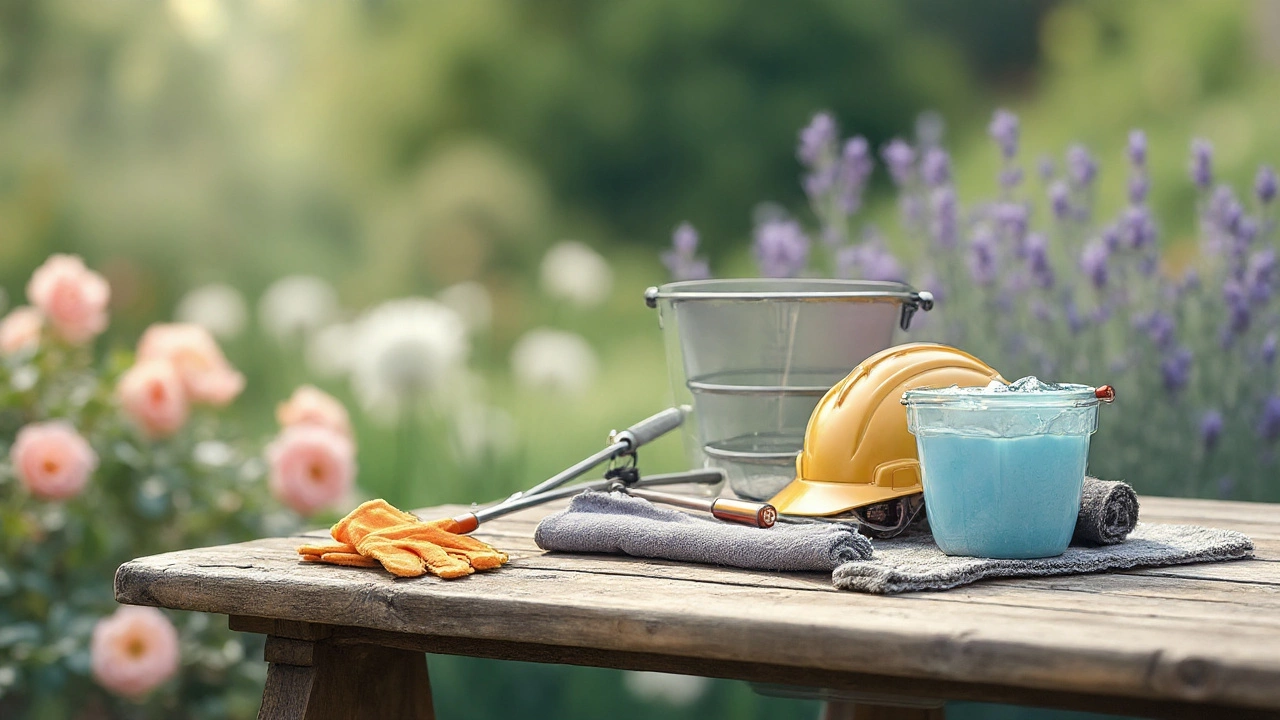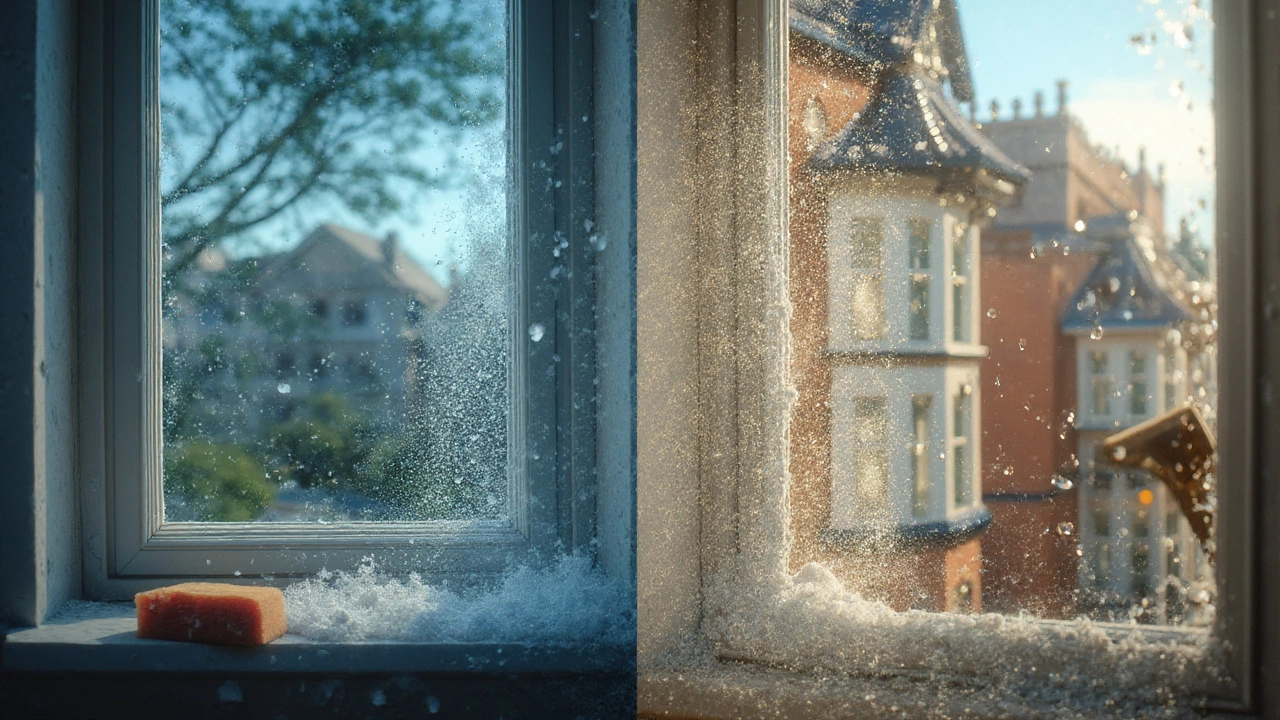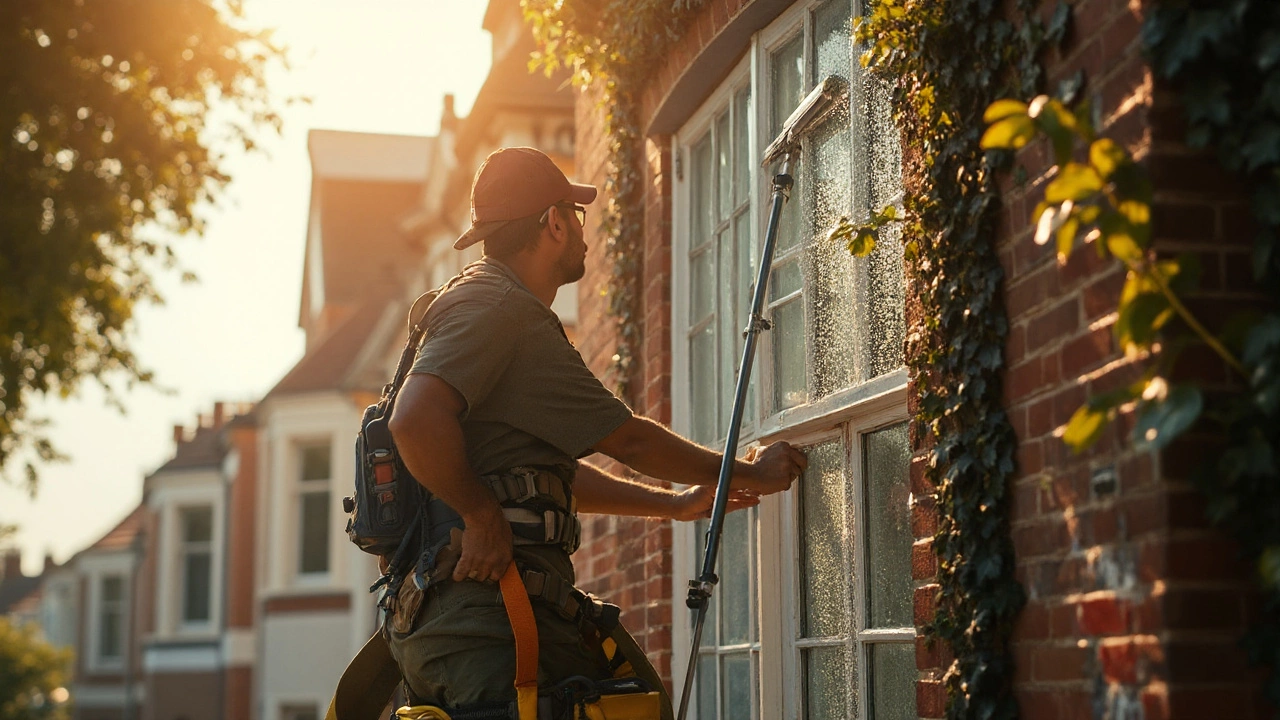Exterior Window Cleaning Planner
Enter your project details
Outside Window Cleaning is a process of removing dirt, grime, mineral deposits, and water spots from the exterior surface of glass panes. It looks simple until you factor in height, weather, and the right tools. Below you’ll find a complete guide that walks you through the whole job - from prep to protection - so you can achieve streak‑free results without hiring a pro.
Quick Take
- Start with a gentle rinse to wash away loose debris.
- Use a squeegee with a smooth rubber blade to pull water off the glass.
- Combine a diluted window cleaning solution (vinegar‑water mix works well) with a soft‑bristle brush for stubborn spots.
- Reach high panes safely using an extension pole or a water‑fed pole system.
- Finish with a microfiber cloth to polish edges and apply a hydrophobic coating for rain‑proofing.
Why Proper Outside Window Cleaning Matters
Dirty exteriors not only look unsightly, they can accelerate glass degradation. Acidic rain and bird droppings etch the surface, leading to costly replacements. Regular cleaning removes these agents, maintains UV protection, and improves natural light inside your home. Moreover, a clean facade boosts curb‑appeal and can raise property value by up to 5% according to the UK Home Survey 2024.
Essential Tools & Materials
Before you climb a ladder, gather the following items. Each is introduced with its key attributes so you know why it matters.
- Squeegee - a handheld tool with a rubber blade; blade width 12-16in, ergonomic handle, and interchangeable blades for different window sizes.
- Extension Pole - telescopic aluminum or carbon‑fiber pole; reach up to 15ft, lightweight (2kg), compatible with most squeegees and brushes.
- Window Cleaning Solution - non‑abrasive formula; homemade version: 1part white vinegar, 4parts distilled water, a few drops of dish soap (pH≈7). Effective on mineral deposits without damaging sealants.
- Soft‑Bristle Brush - nylon bristles, 2‑in width, ideal for scrubbing stubborn grime without scratching glass.
- Microfiber Cloth - 80gsm, high‑loft weave; absorbs 5× its weight in water, leaves no lint.
- Ladder Safety Kit - includes level‑foot stabilizers, fall‑arrest strap, and non‑slip platform; essential for two‑story homes.
- Water‑Fed Pole System - uses purified water (≤5ppm) pumped through a brush head; eliminates need for detergent, reduces streaks.
Step‑by‑Step Guide to Spotless Exterior Glass
- Prep the Area. Clear any plants or furniture near the window. Sweep the sill to avoid debris falling on the glass during cleaning.
- Rinse with Low‑Pressure Water. Use a garden hose set to a gentle spray (≈30psi). This washes away loose dust and prevents scratching when you start scrubbing.
- Apply Cleaning Solution. Fill a bucket with the vinegar‑water mix. Dip the brush, scrub the pane in a circular motion, paying extra attention to corners where bird droppings collect.
- Scrape Stubborn Stains. For sap or paint splatter, gently use a plastic scraper at a 45° angle. Avoid metal tools - they can chip the glass.
- Squeegee the Water Off. Starting at the top corner, pull the squeegee horizontally across the pane. Wipe the blade with a clean microfiber cloth after each pass to avoid re‑depositing grime.
- Polish Edges. Run a dry microfiber cloth along the frame and sealing edges to catch any remaining drips.
- Optional: Apply Hydrophobic Coating. Spray a thin layer of rain‑repellent (e.g., a silica‑based product). This creates a water‑beading effect, extending the clean period by weeks.
- Safety Check. After finishing, inspect the ladder and pole for wear. Store all tools in a dry place to prevent rust.

Comparing Popular Cleaning Methods
| Method | Equipment Needed | Reach (ft) | Water Usage (L per window) | Time (min per 3×3ft pane) | Best For |
|---|---|---|---|---|---|
| Traditional Hand‑Wash | Squeegee, bucket, brush, ladder | Up to 8 | 8‑12 | 12‑15 | Low‑rise homes, budget‑friendly |
| Water‑Fed Pole System | Purified‑water pump, pole‑mounted brush | Up to 20 | 2‑4 | 6‑8 | Multi‑story houses, eco‑conscious |
| Pressure Washer | Pressure gun, extension wand, safety goggles | Up to 12 | 5‑7 | 10‑12 | Heavy grime, commercial façades |
| Magnetic Cleaner | Magnetic rollers, cleaning solution | Up to 6 (internal only) | 1‑2 | 4‑6 | Two‑sided panes where ladder access is risky |
The table shows why the water‑fed pole system often wins for *outside window cleaning*: less water, quicker runs, and no need for ladders on higher stories. However, if you’re on a tight budget, the classic hand‑wash still gets the job done.
Safety First - Working at Height
Climbing a ladder with a bucket of water is a recipe for a slip. Follow these simple rules:
- Inspect the ladder for cracks before each use; replace any damaged sections.
- Position the ladder at a 75° angle (1ft out for every 4ft of height).
- Never overreach - keep your hips within the ladder’s side rails.
- Wear non‑slip shoes and use a harness if you exceed 12ft.
- Keep a second person on standby to hand you tools and catch falls.
Remember, the Ladder Safety Kit is a small investment that can prevent serious injury.
Maintaining Clean Windows Year‑Round
Cleaning once a year leaves windows vulnerable to new smudges. Adopt a maintenance routine:
- Rinse with a garden hose after heavy rain to wash away mineral buildup.
- Spot‑clean bird droppings within 24hours using a soft brush and diluted solution.
- Re‑apply a hydrophobic coating every 6‑8weeks for optimal water‑beading.
- Inspect seals and frames for cracks; seal any gaps to stop water intrusion.
These simple habits extend the life of your glass and keep the view crystal clear.
When to Call a Professional
Even the best DIY method has limits. Consider hiring a pro if you encounter any of the following:
- Windows higher than 30ft - specialized rope access is safer.
- Stubborn graffiti or industrial grime - may need specialized solvents.
- Historic or double‑glazed units with sealed edges - improper pressure can cause leaks.
Professional services often use pure‑water systems that leave zero residue, but the cost varies between £150‑£350 per house.
Next Steps & Further Reading
This guide fits into the broader “Home Improvement” cluster - after mastering external glass, you might explore interior window cleaning, glazing repair, or energy‑saving window upgrades. Look for articles on “how to apply a rain‑proof coating” and “DIY ladder stabilizers” to deepen your skill set.

Frequently Asked Questions
Can I use regular dish soap instead of vinegar for the cleaning solution?
Yes, a few drops of mild dish soap in warm water works, but vinegar cuts mineral deposits more efficiently. If you’re sensitive to acid, stick with the soap‑only mix.
Is a water‑fed pole system worth the investment?
For homes with two or more storeys, the system saves time, reduces water use, and eliminates the need for ladders. The upfront cost (£300‑£500) pays off after a few seasons of use.
How often should I re‑apply a hydrophobic coating?
Typically every 6-8weeks, or after a heavy rainstorm. The coating will bead water, making future cleaning faster.
What safety gear do I need for ladder work?
Non‑slip shoes, a stable ladder with levelers, a fall‑arrest strap, and a second person to hold the ladder. A hard hat is optional but recommended on construction sites.
Can a pressure washer damage my windows?
If set above 1500psi or used too close, it can shatter tempered glass. Stick to low‑pressure settings (≈1200psi) and keep the nozzle at least 12in away.
What’s the best time of day to clean windows?
Early morning or late afternoon when the glass is cool and sunlight is indirect. Direct sun causes the solution to dry too quickly, leading to streaks.
